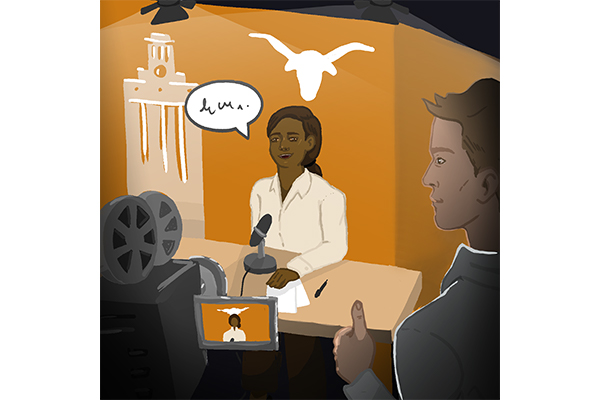Some professors have joined the ranks of YouTubers and influencers in using studio equipment and lighting to film their classes and perfect their angles.
On March 11, when UT announced a spring break extension due to COVID-19, Liberal Arts Instructional Technology Services began working on a plan to use their studio resources for widespread online learning.
LAITS has been filming professors in their studio to create online coursework since 2013. Now, they’ve helped over 100 classes switch from in-person courses to online formats. LAITS not only assists with technology but also improves professors’ on-camera presence and digital teaching quality.
“Why would professors ever think about this, right? You don't need to worry about that when you're in a classroom,” said Michael Heidenreich, director of studio operations with LAITS. “Professors don't become professors to be TV stars.”
When campus closed in March, Heidenreich and his team created the Remote Studio System, which allows professors to teach from their homes. This fall, professors can also teach from a classroom studio in Mezes Hall, which LAITS calls the Remotely Switched Classroom.
“So, (we say to professors) ‘Let's start with your discipline. How (do) you normally teach?’ And then, ‘Let's talk about ways to achieve that and more online,’” said Marla Gilliland, director of course development.
Ann Johns, art and art history senior lecturer, said she has produced online courses in the studio with LAITS since 2015.
“When you're recording in a studio, it's much closer to being in a classroom in terms of it feels real, (and) even though there's cameras, there's people behind the cameras,” Johns said. “This Zoom thing just feels so strange to be sort of pouring your heart out about something to a computer screen in your house.”
She said she is now teaching with the Remote Studio System and prefers this format over Zoom. In the system, professors are given studio equipment to use at home while directors work remotely to send the lectures to UT servers. Technical directors assist professors in transitioning between presentation slides, giving demonstrations and using the equipment.
Gilliland said the student experience is at the center of the work they do when producing these online classes.
“If you are taking an online class, you don't really want to be left alone in cyberspace to wade through material,” Gilliland said. “You want the ability to engage and interact, and we want to enable that.”
Heidenreich said he hopes students and faculty have a positive experience communicating and engaging with their courses through the help of LAITS.
“Hopefully very soon, we're back to a much more normal in-person experience,” Heidenreich said. “But this could be a way we can help UT reinvent itself for the next 150 years or so, and students will play a great role because they're the ones who will say (what) works or doesn't.”















